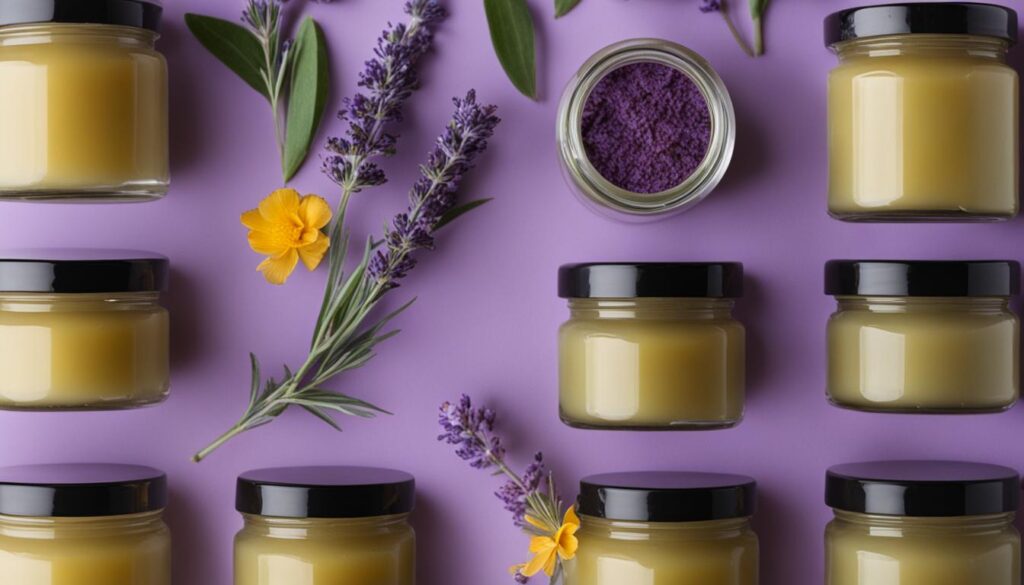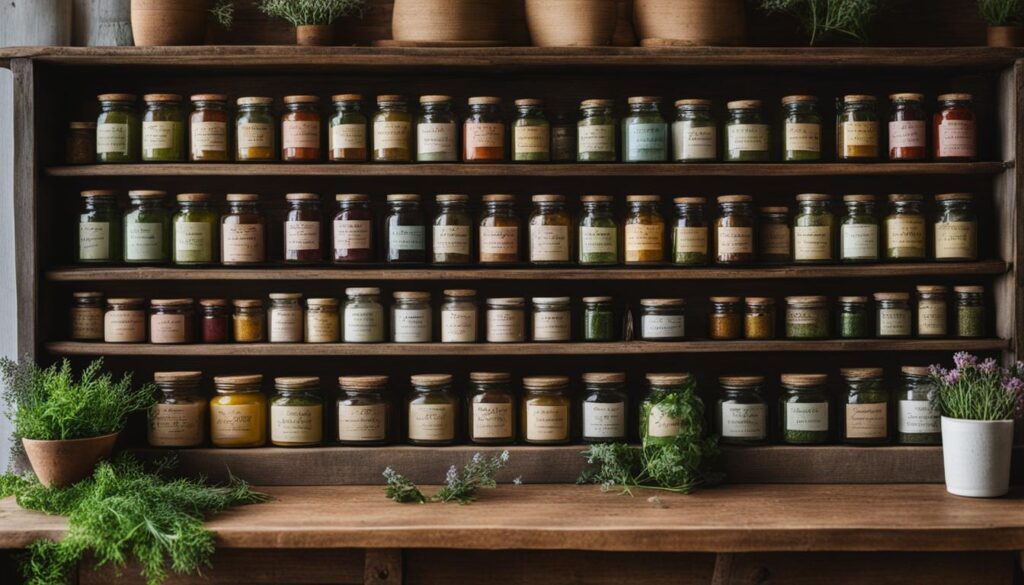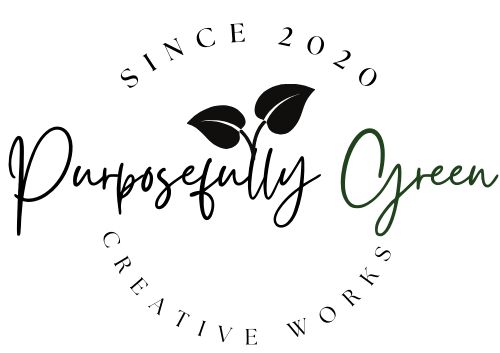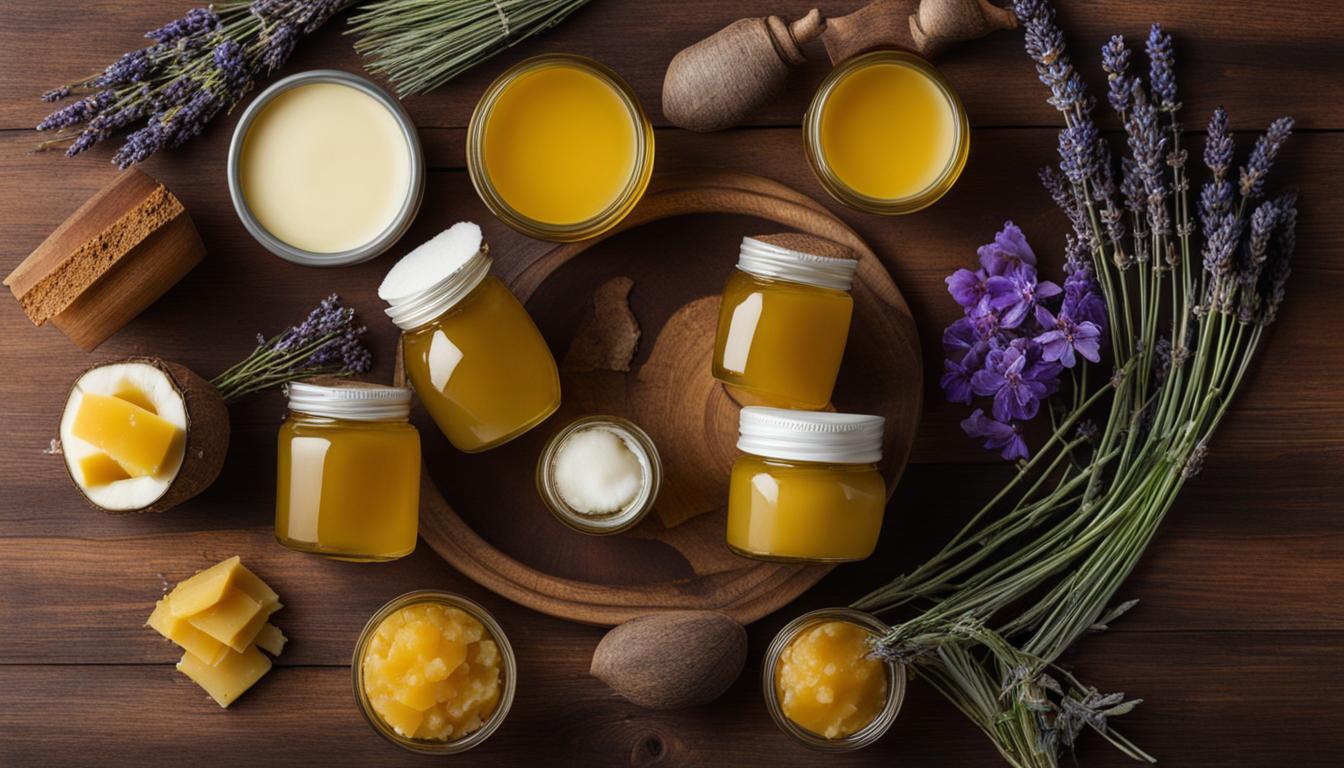Hi there! Are you tired of dealing with irritated and sensitive skin? I know I am. It can be frustrating and uncomfortable to constantly battle with redness, itching, and dryness. But fret not, because I’ve got a solution for you: DIY healing balms!
These natural healing balms can provide the relief your sensitive skin needs. By making your own homemade skin care products, you have complete control over the ingredients and can ensure that they are gentle and soothing, tailored specifically to your skin’s needs.
So, say goodbye to expensive and ineffective commercial products, and let’s embark on a journey of DIY skincare that will bring you the much-needed relief you’ve been seeking.
Key Takeaways:
- Ditch the expensive and ineffective commercial products for DIY healing balms.
- Homemade balms allow you to control the ingredients and ensure they are gentle and soothing for sensitive skin.
- Customize your own skincare products to address your specific skin concerns.
- Experience the healing properties of natural ingredients for relief from sensitive skin issues.
- Enjoy the satisfaction of creating your own personalized skin care routine.
Understanding the Benefits of DIY Healing Balms
When it comes to finding relief for sensitive skin, DIY healing balms are a game-changer. These soothing balms offer a natural alternative to commercial skincare products, harnessing the healing properties of DIY balms to alleviate discomfort and nourish your skin.
With their gentle yet effective formulations, DIY healing balms provide a range of benefits for sensitive skin. Whether you’re looking for remedies that relieve pain, reduce inflammation, or calm itchiness, these balms have got you covered.
One of the greatest advantages of DIY healing balms is their healing properties. Made with carefully selected natural ingredients, these balms can help soothe and heal various skin problems. From dryness and redness to eczema and dermatitis, these balms offer targeted relief for a wide range of sensitive skin concerns, making them an indispensable part of your skincare routine.
By creating your own balms, you have the flexibility to customize the formulation to your specific needs. You can experiment with different ingredients and ratios to find the perfect blend that works best for your skin. Plus, you’ll have peace of mind knowing exactly what goes into your skincare products, avoiding any potentially harmful chemicals or irritating additives.
Let’s dive deeper into the benefits of DIY healing balms:
- Relief from Pain and Itchiness: DIY balms are formulated to provide immediate relief from pain and itchiness associated with sensitive skin conditions. Soothing ingredients like aloe vera, chamomile, and calendula work together to calm inflammation and ease discomfort, allowing your skin to heal naturally.
- Natural Healing Properties: Unlike commercial products that may contain synthetic or harsh ingredients, DIY balms are made with the healing power of nature. Organic oils, botanical extracts, and essential oils are carefully chosen for their anti-inflammatory, antimicrobial, and soothing properties, helping to restore your skin’s health.
- Gentle on Sensitive Skin: DIY healing balms are formulated with sensitive skin in mind. The natural ingredients used are gentle and non-irritating, making them suitable for individuals with reactive skin. Say goodbye to redness, stinging, and irritation, and hello to a calmer, more comfortable complexion.
Discover the incredible healing properties of DIY balms that bring relief to sensitive skin. Whether you’re looking for soothing balms for sensitive skin or remedies to alleviate discomfort, these homemade skincare products offer a natural and effective solution.
Start your journey towards healthier, happier skin with DIY healing balms!
| Soothing Balms for Sensitive Skin | Key Benefits |
|---|---|
| Calendula Balm | Soothes inflammation and speeds up skin healing. |
| Chamomile Balm | Calms redness and irritation, promoting a healthy complexion. |
| Lavender Balm | Relieves itching and soothes sensitive skin, promoting relaxation. |
| Cucumber Balm | Hydrates and cools the skin, reducing redness and irritation. |
Key Ingredients for DIY Healing Balms
When it comes to DIY skincare for sensitive skin, using the right ingredients is key. Homemade healing balms offer a range of benefits, providing natural remedies for sensitive skin relief. By incorporating these key ingredients into your homemade balms, you can create soothing and nourishing skincare products tailored to your skin’s needs.
1. Shea Butter
Shea butter is a popular ingredient in DIY healing balms for sensitive skin. It is rich in vitamins A, E, and F, which help moisturize and nourish the skin. Shea butter also contains fatty acids that promote skin healing and reduce inflammation, making it especially beneficial for sensitive or irritated skin.
2. Cocoa Butter
Cocoa butter is another excellent ingredient for homemade healing balms. It is known for its deep moisturizing properties, helping to restore and soften dry, sensitive skin. Cocoa butter also contains antioxidants that protect the skin from free radicals, promoting healthy skin cell regeneration.
3. Castor Oil
Castor oil is a versatile ingredient that offers various benefits for sensitive skin. It has anti-inflammatory properties that can help reduce redness and irritation. Castor oil is also moisturizing, making it ideal for dry or chapped skin. Additionally, its antimicrobial properties can help prevent infections and promote faster healing of skin issues.
4. Sweet Almond Oil
Sweet almond oil is a lightweight oil that works well in DIY balms for sensitive skin. It is rich in vitamins A and E, which help nourish and protect the skin. Sweet almond oil is easily absorbed, leaving the skin feeling soft and moisturized without greasiness. It also has anti-inflammatory properties that can help calm sensitive or inflamed skin.
5. Neem Oil
Neem oil is a powerful ingredient often used in natural remedies for sensitive skin relief. It has antimicrobial, anti-inflammatory, and antioxidant properties that can soothe and heal various skin conditions. Neem oil is particularly effective for addressing acne-prone or irritated skin, making it a great addition to DIY healing balms.
6. Vitamin E Oil
Vitamin E oil is a popular ingredient in homemade healing balms for sensitive skin. It has antioxidant properties that protect the skin from damage caused by free radicals. Vitamin E oil also helps to moisturize and nourish the skin, promoting overall skin health and aiding in the healing process.
By incorporating these key ingredients into your DIY healing balms, you can create effective and gentle skincare products. These natural remedies for sensitive skin relief offer the benefits of moisturization, soothing, and healing without the harsh chemicals often found in commercial products.
Now that you have an understanding of the key ingredients for DIY healing balms, let’s move on to the next section where we’ll explore a simple recipe to create your own healing balm for sensitive skin.

| Key Ingredients | Benefits |
|---|---|
| Shea Butter | Moisturizes and nourishes the skin, reduces inflammation |
| Cocoa Butter | Deeply moisturizes and promotes healthy skin cell regeneration |
| Castor Oil | Reduces redness and irritation, moisturizes and helps prevent infections |
| Sweet Almond Oil | Nourishes and protects the skin, calms sensitive or inflamed skin |
| Neem Oil | Soothes and heals various skin conditions, effective for acne-prone or irritated skin |
| Vitamin E Oil | Protects the skin from free radicals, moisturizes and aids in the healing process |
DIY Healing Balm Recipe for Sensitive Skin
Looking for a simple yet effective homemade skincare product to soothe your sensitive skin? Try this easy DIY healing balm recipe that utilizes natural ingredients known for their healing properties.

This healing balm combines the moisturizing power of shea butter and cocoa butter with the soothing properties of castor oil, sweet almond oil, neem oil, and vitamin E oil. These natural ingredients work together to provide relief for sensitive skin while nourishing and protecting it.
Here’s how to make your own healing balm:
- Start by gathering the following ingredients:
- 1.5oz shea butter
- 1oz cocoa butter
- 0.70oz castor oil
- 1oz sweet almond oil
- 0.35oz neem oil
- 1/4 tsp vitamin E oil
- Combine all the ingredients in a double-boiler or a glass bowl placed in a pan of hot water.
- Melt the oils over medium heat until they are completely liquid.
- Once melted, remove the bowl from heat and place it in the freezer for about five minutes or until the oils start to thicken.
- Take the bowl out of the freezer and use a whisk to beat the mixture until it reaches a creamy consistency. Add a few drops of your favorite fragrance oil if desired.
- Spoon the finished balm into a clean container with a lid.
- Store your homemade healing balm in a cool, dry place and apply it as needed to soothe your sensitive skin.
With just a few simple steps, you can create a natural healing balm that provides relief for your sensitive skin. Enjoy the soothing benefits and the peace of mind that comes from using homemade, chemical-free skincare products.
Importance of Patch Testing and Precautions
When it comes to trying out new skincare products, including DIY healing balms, it’s essential to prioritize your skin’s safety and well-being. Patch testing is a crucial step to ensure that the product you plan to use doesn’t cause any adverse reactions or sensitivity. This is particularly important for individuals with sensitive skin, who may be prone to allergic reactions.
One ingredient that can cause sensitivity for some individuals is neem oil. While it offers many benefits for skincare, it’s important to be cautious if you have a known sensitivity or allergy to neem oil. Patch testing can help determine whether neem oil is suitable for your skin or if you need to explore alternative options.
“Patch testing allows you to identify potential reactions and take the necessary precautions for a safe and pleasant skincare experience.”
Performing a patch test is simple. Follow these steps:
- Clean a small area of skin, such as the inner forearm or behind the ear.
- Apply a small amount of the DIY healing balm to the cleansed area.
- Leave it on for 24 hours without washing or rubbing the area.
- Observe for any signs of redness, itching, or irritation during and after the 24-hour period.
- If no adverse reactions occur, the healing balm is likely safe for use. However, if any discomfort or irritation arises, it’s best to discontinue use and consult a dermatologist or healthcare professional.
It’s crucial to note that pregnant women should exercise caution when using neem oil or any other essential oils during pregnancy. Neem oil has been associated with potential adverse effects on pregnancy, and it’s always advisable to consult with a healthcare professional before introducing any new skincare product.
Precautions for Using Neem Oil During Pregnancy
While neem oil can provide benefits for the skin and hair, it’s essential to prioritize the safety and well-being of both the mother and the baby. Here are some precautions to consider:
- Avoid using neem oil during the first trimester when the baby’s vital organs are forming.
- Consult with a healthcare professional before using neem oil in any form (topical or oral).
- Consider alternative skincare options that are deemed safe for use during pregnancy.
Remember, always prioritize your safety and consult with a healthcare professional or dermatologist if you have any concerns or questions regarding the use of neem oil or any other skincare products during pregnancy.
| Precautions | Benefits |
|---|---|
| Avoid using neem oil during pregnancy | Safe and enjoyable skincare experience |
| Perform a patch test to identify potential reactions | Smooth, healthy, and radiant skin |
| Consult a healthcare professional before using neem oil | Nourishing and moisturizing properties |
Remember:
When it comes to your skincare routine, it’s better to be safe than sorry. Take the necessary precautions, such as patch testing and consulting with a healthcare professional, to ensure a delightful and hassle-free experience. Your skin deserves the best!
Other DIY Balms for Different Skin Concerns
When it comes to DIY healing balms, the possibilities are endless. Not only can you create balms for sensitive skin relief, but you can also customize them to address specific skin concerns. Here are some examples of DIY balms for different skin conditions:
- Eczema Balm: DIY healing balms for eczema can help soothe and moisturize dry, itchy skin. They often contain ingredients like shea butter, oatmeal, and chamomile, which have anti-inflammatory properties.
- Cuticle Balm: Give your nails some TLC with a homemade cuticle balm. This balm can help nourish and soften your cuticles, promoting healthy nail growth. Ingredients like beeswax, coconut oil, and vitamin E oil are commonly used in cuticle balms.
- Foot Care Balm: DIY balms for foot care can help heal cracked heels, soothe tired feet, and eliminate odor. Ingredients like peppermint oil, tea tree oil, and shea butter are often included in foot care balms.
- Pain Relief Balm: If you suffer from muscle aches or joint pain, a DIY pain relief balm may be just what you need. These balms often contain ingredients like arnica, menthol, and eucalyptus oil, which can provide temporary relief from discomfort.
- Tattoo Aftercare Balm: After getting a new tattoo, proper aftercare is essential. DIY tattoo aftercare balms help soothe and protect the skin, promoting faster healing. Ingredients like coconut oil, beeswax, and lavender essential oil are commonly used in tattoo aftercare balms.
These DIY balms utilize different herbal ingredients and oils to provide relief for specific skin conditions and irritations. By tailoring your balms to your needs, you can experience the remarkable benefits of natural remedies for skin irritation.
Enjoy the journey of discovering the perfect homemade healing balms for your unique skin concerns. Experiment with different ingredients and find what works best for you. Remember, self-care starts with self-love, and what better way to show love to your skin than with these DIY balms?
Exploring the World of Homemade Balms and Salves
When it comes to finding natural remedies for sensitive skin, homemade skincare products are a fantastic option. You have the power to create your own DIY salve and balm recipes using all-natural ingredients that are gentle yet effective. Let’s dive into the wonderful world of homemade balms and salves!
One of the great advantages of homemade balms and salves is that you have complete control over what goes into them. You can choose high-quality, organic ingredients that are tailored to your specific skin needs. Say goodbye to harsh chemicals and additives found in many commercial skincare products.
“Why should I make my own balms and salves?” you might wonder. Well, let me share a few reasons with you:
- Natural remedies for sensitive skin: When dealing with sensitive skin, it’s important to avoid products that can cause irritation or redness. Homemade balms and salves are made from gentle, natural ingredients that can calm and soothe sensitive skin without any harsh side effects.
- Customized skincare: Have you ever struggled to find a store-bought product that perfectly suits your skin type? By making your own balms and salves, you can tailor them to your specific needs. Whether you’re dealing with dryness, acne, or other skin concerns, you can create a product that addresses your unique skincare needs.
- Cost-effective: Creating your own skincare products can actually save you money in the long run. Many store-bought products come with hefty price tags due to branding and marketing. By making your own balms and salves, you can enjoy luxurious skincare without breaking the bank.
Now, let’s take a closer look at some popular DIY balms and salves that you can easily whip up in your own kitchen.
Calming Lavender Salve
This lavender-infused salve is perfect for soothing sensitive skin and promoting relaxation. Here’s what you’ll need:
| Ingredients | Benefits |
|---|---|
| 1/2 cup olive oil | Moisturizes and nourishes the skin |
| 1/4 cup beeswax | Adds a protective barrier to the skin |
| 15 drops lavender essential oil | Calms and soothes the skin |
Heat the olive oil and beeswax in a double boiler until melted. Remove from heat and stir in the lavender essential oil. Pour the mixture into a container and let it cool and solidify. Apply to clean skin as needed.
Healing Calendula Balm
If you’re looking to heal dry or irritated skin, this calendula balm is the perfect choice. Here are the ingredients to gather:
| Ingredients | Benefits |
|---|---|
| 1 cup coconut oil | Moisturizes and soothes the skin |
| 1/2 cup dried calendula flowers | Has anti-inflammatory and healing properties |
| 1/4 cup beeswax | Forms a protective barrier on the skin |
Combine the coconut oil and dried calendula flowers in a heat-safe jar. Place the jar in a saucepan filled with water and simmer on low heat for 2-3 hours. Strain the oil to remove the flowers, then return the oil to the jar and add the beeswax. Heat until melted, then pour into containers and let it solidify. Apply to dry or irritated skin as needed.
These are just a few examples of the many DIY salve and balm recipes available. Get creative and experiment with different herbal-infused oils, plant-based ingredients, and essential oils to find the perfect combination for your sensitive skin. Your skin will thank you for the nourishment and care provided by your homemade creations!
Conclusion
Relief from sensitive skin is within your reach with DIY skincare remedies and homemade healing balms. By taking matters into your own hands and creating your own balms using natural ingredients, you can cater to the specific needs of your sensitive skin. Say goodbye to commercial skincare products filled with harsh chemicals and hello to the soothing, moisturizing, and healing properties of your homemade creations.
Discovering the perfect homemade healing balm for your sensitive skin requires some experimentation. You have the freedom to explore different recipes and ingredients until you find the ideal combination that brings you the much-needed relief. From shea butter to sweet almond oil and everything in between, the options are endless. Don’t be afraid to get creative and find what works best for you.
DIY healing balms not only alleviate sensitive skin conditions but also offer a sense of satisfaction and empowerment. Knowing that you are using natural remedies that you made yourself gives you the confidence that you are taking care of your skin in the best possible way. So, roll up your sleeves, gather your ingredients, and embark on an exciting journey of DIY skincare. Your sensitive skin will thank you!
FAQ
What are the benefits of DIY healing balms for sensitive skin?
DIY healing balms offer various benefits for sensitive skin. They have healing properties that can soothe and alleviate uncomfortable skin problems. These balms provide relief from pain and itchiness and are made with natural ingredients that are gentle on sensitive skin. They offer a natural alternative to commercial skincare products and can be customized to suit individual needs.
What are the key ingredients for DIY healing balms?
Common ingredients for DIY healing balms include shea butter, cocoa butter, castor oil, sweet almond oil, neem oil, and vitamin E oil. These ingredients have moisturizing, soothing, and healing properties that provide relief for sensitive skin. They are also natural and free from harsh chemicals that can irritate the skin.
Can you share a DIY healing balm recipe for sensitive skin?
Certainly! Here is a simple DIY healing balm recipe for sensitive skin: – Combine 1.5oz shea butter, 1oz cocoa butter, 0.70oz castor oil, 1oz sweet almond oil, 0.35oz neem oil, and 1/4 tsp vitamin E oil in a double-boiler or a glass bowl placed in a pan of hot water. – Melt the oils over medium heat until completely liquid, then place the bowl in the freezer for five minutes or until the oils thicken. – Remove from the freezer and beat the mixture with a whisk, adding fragrance oil if desired. – Spoon the finished balm into a container with a lid and enjoy the soothing benefits on your sensitive skin.
What precautions should be taken when using DIY healing balms?
It’s important to conduct a patch test before using DIY healing balms or any new skincare product. This helps check for any potential sensitivity or allergic reactions. Some people may have sensitivity to neem oil and fragrance oil, so it’s important to perform a skin patch test. Additionally, pregnant women should avoid using neem oil as it may have adverse effects on pregnancy and should consult with a medical professional before using any new skincare product.
Are there DIY balms for specific skin concerns?
Yes, DIY balms can be customized to address specific skin concerns. For example, there are DIY balms for eczema, healing cuticles, foot care, pain relief, and even tattoo aftercare. These balms utilize different herbal ingredients and oils to provide relief for specific skin conditions and irritations.
Are there other natural remedies for sensitive skin relief?
Absolutely! Homemade balms and salves offer a world of possibilities when it comes to natural remedies for sensitive skin. From herbal-infused oils to various plant-based ingredients, there are numerous DIY salve and balm recipes available. These recipes are designed to heal, nourish, and moisturize the skin using all-natural ingredients, making them a great alternative to commercial skincare products.


[…] 2. Gentle on the skin: Organic ingredients are gentler on the skin than synthetic ones, making them ideal for those with sensitive skin. […]
[…] Generally gentle and suitable for sensitive skin […]
[…] work really well for me and many people I’ve tried it with. It might not work for you if your skin doesn’t like it or is too sensitive for some of the products. Always consult a professional like your dermatologist or doctor before […]
[…] your choice of essential oils. For this mask I wanted something that would soothe redness and help sensitive skin and acne. I chose to make a matcha clay mask because of all the wonderful properties that green tea […]
[…] of exposing your skin to potential irritants. This can be particularly beneficial for those with sensitive skin or conditions such as eczema or […]
[…] Tip: Exfoliate your skin 2-3 times a week for best results. Be sure to adjust the frequency based on your skin’s individual needs and sensitivity. […]
[…] Organic skincare is gentle on the skin because it doesn’t contain harsh synthetic chemicals that can strip away natural oils or irritate the skin. Instead, it’s packed with natural ingredients that nourish and hydrate the skin without causing any harm. Organic skincare products can help improve the skin’s texture and overall appearance, making it perfect for those with sensitive skin. […]
[…] Butter: Moisturizing and nourishing, shea butter is perfect for dry and sensitive skin […]
[…] Protects against free radicals and aids in skin healing […]
[…] products on a small area of skin before applying them to your entire face, especially if you have sensitive skin or […]